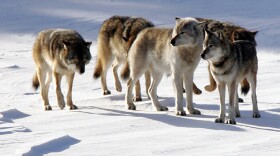In the last year, seven wolves on Isle Royale died. The total population is now down to nine wolves.
That's the lowest number recorded by researchers who have been studying the Isle Royale wolf population for the last 54 years. It's the longest continuous predator-prey study in the world.
When Rebecca Williams and I visited Rolf Peterson on Isle Royale last month, we asked him about the die-off.
He told us they didn't know what happened to them, "but we will know," he said.
Well, now they know how three of the seven wolves died. One was a young female wolf.From a Michigan Tech press release:
In late May, National Park Service biologist Ted Gostomsk reported one or more animal carcasses floating in water in a deep, 19th century mine shaft at Isle Royale. With the aid of the Park Service, Peterson and his wife, Carolyn, went in to investigate. They recovered and examined what was left of the animals and then collected the bones.. "We found there had been a real catastrophe in early winter, before we arrived on the island in January,” said Vucetich. “There were three dead wolves from the Chippewa Harbor Pack in the shaft: a collared male that we had been unable to locate this winter, an older male—maybe the alpha male—and a female born in 2011. “We believe the incident occurred between mid-October and mid-January,” Vucetich went on to say. “There is no way to know how the three wolves ended up falling into the pit, but very likely, accumulating snow and ice played a role in the accident.
The collared wolf was named Romeo, so named for his showing his eagerness to mate.
In an email, Rolf Peterson says they still don't know what happened to the other four wolves that died in the past year.
"But the mine event is what makes the past year stand out from the usual background annual mortality (25% or so). My favorite hypothesis of the day (suggested by our pilot) is that the 3 wolves scrambled down the hole to check something out. Initially the water surface was frozen (placing it in December), but with three wolves the ice broke up and the wolves had trouble negotiating an escape out of the ice water and succumbed to hypothermia (drowning). This is consistent with the scant evidence we have, but there are other equally valid scenarios. There are other mine shafts on the island, and moose have gone into them many times, but this shaft was not known to anyone or mapped."
John Vucetich said they now know why there was such a big decline in the Chippewa Harbor Pack in the last year:
"...and perhaps why we saw such a desultory pattern of travel and low kill rate in this pack,” Vucetich said. The pack seemed to have no “game plan” following the large loss of so many individuals, he explained.
They say losing a young female wolf on the island came at a bad time when there are so few female wolves for the others to mate with. The researchers know of only two female wolves left on Isle Royale.
Rolf Peterson and John Vucetich will examine the bones of the dead wolves and collect more data:
Peterson and Vucetich are cleaning the bones of the dead wolves and examining their spines—affected by inbreeding history—to collect some data about the animals. They will also be doing DNA analysis to determine or confirm the animals’ age and prior history.
To learn more about Isle Royale's wolves and the people who study them, visit our page: Lessons learned from Isle Royale's Wolves and Moose.











